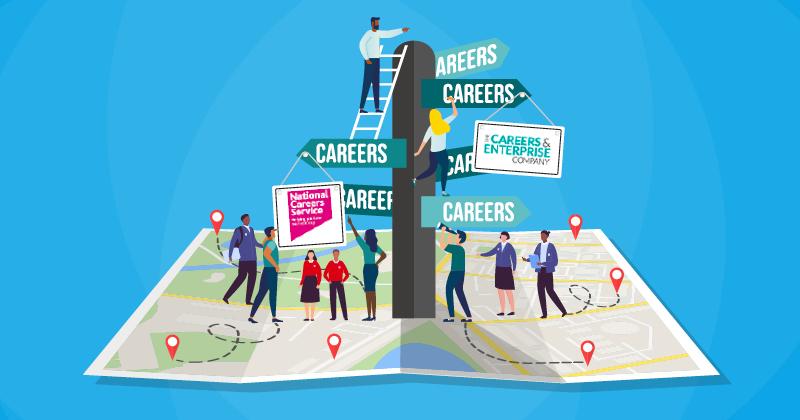Do you want the perfect career, but not sure how to get it?
We have picked out some top tips to help you discover your dream job, and easily map out how to achieve it.

Some of us are drawn to specific career paths from a young age. For others, choosing a career can be a slightly more complex matter.
The sheer number of different options can be overwhelming, with the fear of making the wrong career choice very real.
This variety also means, however, that it’s highly likely that there will an ideal job out there for everyone. It’s just a matter of identifying the correct career path and taking the first steps.
In order to do so, it can be beneficial to take a methodical approach.
Here’s a step-to-step guide finding your ideal job.
- Conduct a self-assessment
The first step to choosing a career is to understand your own skills, interests, and ambitions.
Establishing these will give you some much-needed clarity. Remember understanding your own desires and abilities is a big step towards choosing a career.
Speak to colleagues, friends, and others who know you in different capacities.
They will be able to give you insights into yourself of which you may well not be aware.
Don’t be afraid to ask about your weaknesses too.
When understanding the wrong career environment bases on your weaknesses, will help you narrow down the right one.
Think about how you like to work:
Do you love being part of team, or are you a lone wolf?
Do you want an office job, or to work in the field?
Do you want a career in the public eye or behind the scenes?
Don’t forget to identify your interests. You may well be able to choose a career directly related to them. If not, they could still be insightful. Even if you can’t be a full-time musician, you could glean that creativity is one of your assets.
Your interests are a key determinant of the sorts of jobs which you would enjoy.
A job at which you are great but in which you are uninterested may leave you feeling unfulfilled.
Finally – what are your career goals?
Be honest with yourself, rather than trotting out stock answers.
Examples of career goals might relate to wider impact – to engage in public service, or in contribute to scientific advancements.
They could relate to your status: to become a senior manager in a publicly-listed company or to cultivate deep expertise in a particular field.
Maybe it’s about lives you could impact: to help those who need it most or to change how people see the world. It might be that you just want to earn a good salary…
Work through the above, and you’ll have a handle on certain instructional career indicators. With these in hands, we can move to the next step of choosing a career.
2. Match potential career paths
The next step is matching your skills, interests, and career goals with potential career paths
The answer may be staring you in the face.
Bring together the above elements, and you may find that they point to a very specific career path. Consult others as well, they may see patterns you don’t.
Look through jobs boards and listings online and see what sort of job vacancies resonate with your career profile.
Hopefully, the self-assessment exercise will help you narrow this down a little bit.
You can also carry out career-related keyword searches to see what comes up.
There is plenty of career content out there as well, so do some reading.
If you’re unsure about how your profile relates to specific careers, there are a variety of different tools and methods at your disposal.
You will find a range of online career tests, quizzes, and assessments designed to help candidates find the right job.
You could also seek out careers counsellors or recruitment agencies to see what they would recommend. The latter will focus on what’s currently on their books, though this will give you a practical view of job hiring trends.
It is worth thinking in the medium and long term when choosing a career. You may not see a direct skills match with specific careers, but there may be educational paths or training courses available to bridge the gap.
You can also take a bottom-up approach. You may find it more useful to identify educational options that match your skills and interests, then working forward to see which career options these paths match with. Think about options that are open to you, be it a full-time degree or short-online courses trained on specific career skills.
This should leave you with a list of potential career paths open to you. The next step in choosing a career is to narrow it down.
3. Narrow down the options
Now it’s time to refine this list.
You need to weigh up the pros and cons of each career path.
If possible, speak to people who currently work in the field. Ask around to see if there’s anyone in your wider network. If not, make use of online forums or LinkedIn to get in touch to ask (politely) if those working in related jobs can answer a few questions. Again, careers content can help shed some light on various career paths.
Perhaps you would find it useful to conduct a SWOT analysis.
These can be valuable exercises for understanding the pros and cons of each prospective career path for you personally.
To do this, divide a large square into four quadrants. In the top half map out your relevant strengths and weaknesses. This should be fairly straightforward. Then, in the bottom half, opportunities and threats.
Consider opportunities that could help you take steps along this career path, as well as threats that may be impediments. Opportunities might be connections you have, or access to relevant courses. Or they could relate to the general health of the industry itself. Threats may include financial barriers to entry or a shortage of entry-level jobs.
If the strengths and opportunities outweigh weaknesses and threats (in weight, not necessarily quantity) then you might be onto a winning career path.
On the other hand, if the obstacles are insurmountable, then it might be best to choose something else. If you have become passionate about a certain job, however, do ask yourself if you could overcome said obstacles with dedication and patience. Certainly, part-time or online education options have made career training more accessible.
To what extent you narrow down this list of potential careers depends on certain variables. It may be that your skills and interests lead to a few different career paths, all of which are of more-or-less equal appeal. In this case, there may be advantages to keeping your options relatively open. Chiefly, that there will be more jobs open to you.
Make things too broad, however, and you will lose focus. Hiring managers will detect this, and you will miss out to those with a more certain vocation.
If there is a path which has come to appeal to you more than any other, it should be on this you focus. Diluting your attention will cost you vital time and energy. To give yourself a real chance, focus your efforts on this one career path. Your dedication will be noted. That is not to say, however, that you should not have a back-up career plan.
Careers with a high level of buy-in, involving specific training, will also require a tighter focus.
Once we’ve made our career choices, the final step is to think about how to make it a reality.
4. Make a plan of action
The last step of choosing a new career path is to think about the steps you’ll be taking along it.
Here you need to think about long and short-term career goals, working from where you are now to where you ultimately want to be.
Short-term career goals should be very specific and set along a specific timeline. If you need to put your CV in order, set yourself a deadline. If you need to enrol on a course, look at application deadlines and completion dates. If you’re ready to apply for positions, set yourself a minimum threshold of applications to make this week or month.
Be realistic but ambitious. If the timescales you set are too short, you risk getting disheartened by missing goals. On the other hand, a little bit of urgency will help you build up some momentum. Be realistic in your expectations. If it’s a new career path, you’ll have to train and work in entry-level positions, or even complete internships. Career gratification is rarely instant.
This should give you an idea of where you can expect to be when. If your career journey is a longer one, understanding that you are progressing will be heartening.
Also map longer-term career goals. If there are more steps on your career journey, these might include getting your first position or earning required qualifications. Think about your ultimate goals too; the impact you want to make, or the position you want to hold. This latter category of career goals can serve as inspiration. They must be in conjunction with a concrete step-by-step plan of how to get there, however.
A degree of flexibility may be necessary. Perhaps things may not work out as you expect in your career plan. There is the very real possibility of facing setbacks along the way. Where possible you should include some backup options. There are multiple routes along any given career path – or you may want to find a new one altogether. Your priorities or passions may change as you progress. You may become aware of alternative options.
If you find yourself in this position, simply follow the above steps once more. You may find the outcomes are quite different…
What is my first step to a new career?
To start moving towards your new career, you’ll need to make sure you have the skills to do the job. MyTeacher can provide you with the courses and training you need to get up to speed.
We use a variety of online learning modules, including free short courses, to improve your skills level and prepare individuals for the role of their dreams. All our courses are 100% online, which means you can retrain in your own time, at your own pace, with a global community of learners.
Keep your eyes on this platform, as they will soon bring their educational portal (MyTeacher) to your screen right here within the ECOSA Social Network.

Last Updated - 01/03/23




